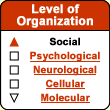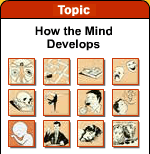|
|
| |
 |
| From Embryo to Ethics |  |
| | |


Many studies have shown that there
are cultural differences in the ways that people assess moral
dilemmas. In one experiment where the subjects included Americans with Christian
backgrounds and Indians with Hindu backgrounds, it was found that on questions
of social responsibility, the Americans focused more on concepts of individuality
and freedom of choice, while the Indians’ culture caused them to place more
emphasis on interpersonal relations and the influence of the community.
This study also revealed other differences between these communities, based on
the same underlying cultural assumptions. For example, the Indian community seemed
to show a greater tendency to pardon certain behaviours than the American community
did. |
Both Kohlberg and Gilligan postulate
that moral judgment arises from an internal model that is constant for any one
individual, regardless of what situation that individual may be facing. But this
does not always seem to be the case. For example, in one more recent study, 85%
of the subjects displayed at least three different stages of Kohlberg’s
model in making their moral decisions, and 25% alternated among five of these
stages! Thus, even if such stages can in fact be defined, it is not at all clear
that individuals always completely abandon a lower stage when they move on to
a higher one. | | | Kohlberg developed his
three major levels of morality and six
specific stages of moral development on the basis of moral dilemmas. The heart
of any moral dilemma is that it forces the individual to make a decision or choose
a course of action that will have implications for other people. For this reason,
some authors have argued that we cannot really call Kohlberg’s stages 1
and 2 moral stages, because children at those stages are still too self-centred
to consider other people at all.
Many other criticisms have also been
made of Kohlberg’s model. Some critics argue that to speak of moral development,
one must have suitable criteria for measuring such development. But to the extent
that Kohlberg’s criteria for judging the morality of any given line of reasoning
are products of their time, they entail certain philosophical presuppositions.
For example, someone living in Ancient Greece could scarcely have judged the morality
of actions according to universal principles of human rights (Kohlberg’s
stage 6), because in those times not all humans were regarded as having the same
rights (for instance, women and slaves had no right to vote). Similarly, some
time later, in places where Christianity became the predominant religion, social
customs could still easily have conflicted with the norms decreed by God and the
Church. Such conflicts would not have made moral judgments easy for people at
Kohlberg’s stage 4! Another criticism of Kohlberg
is made by certain psychologists who believe that the positive
and negative reinforcements that children receive at home have more influence
on their moral development than any natural progression through moral stages such
as Kohlberg proposes.
The methodology of Kohlberg’s studies has
also been questioned in various respects. For example, just because someone says
how he would act if faced with a particular moral dilemma does not necessarily
mean that he would actually act that way. In other words, our actions are influenced
by many other factors besides our moral judgment—factors such as social
pressures, dependencies,
and fears.
Yet another issue: there is some uncertainty as to
whether any given child would be assessed as being at the same stage when interviewed
by two different researchers on two different days.
And what about the differences between
men and women? It is known that in resolving moral dilemmas, women tend to accord
greater importance to interpersonal relations. But this tendency leads interviewers
to assess women as being at earlier moral stages than men who base their judgments
more explicitly on abstract concepts such as justice and fairness, which prevail
at stage 5 or 6. Carol Gilligan was the first to point out that because
Kohlberg derived his stages solely from interviews of males, these stages were
highly likely to be biased in their favour. By listening to numerous women, Gilligan
realized that in women, a “morality of care” quite often took the
place of the morality of laws and justice that predominates among men and that
Kohlberg embraced. | |
In fact, Gilligan found that in men as much as
in women, moral judgments always seem to embody two imperatives: the imperative
to treat others fairly (which is based on justice), and the imperative to help
other people who are in need (which is based on caring). Gilligan’s work
has had a considerable impact, by showing that
paying attention to other people constitutes a fundamental component of our
moral reasoning.
Other studies, conducted
by Elliot Turiel and his colleagues, established a distinction between children’s
development in the moral domain, on the one hand, and in the domains of social
skills (such as adherence to social conventions) on the other. According to these
researchers, children make this distinction naturally as they discover various
forms of social experiences associated with these two kinds of social events.
Social events with moral content are those that have a direct effect on
other people’s well-being, such as hitting them or stealing from them. In
contrast, events that depend on social conventions—for instance, whether
a university student addresses a teacher as “Professor” or uses her
first name instead—generally do not have any intrinsic effect on that person.
Nevertheless, the fact that in a given social context, one of these forms of address
is considered better than the other still shows that conventions play an important
role in facilitating social relationships. | |
Turiel’s contribution to our understanding
of moral development was to show that morality and social conventions follow two
parallel pathways of development, rather than a single path, as Kohlberg had supposed.
But because even the most trivial social event takes
place within a broader social setting, every act of moral reasoning falls
not only within the framework of certain conventions, but also within the broader
framework of a particular cultural and historical
context (see the first sidebar at the top of this page).
Another criticism made regarding
Kohlberg is that he never seems to contemplate the use of moral judgments for
strategic purposes—in other words, to instrumentalize or manipulate people
rather than to get along with them.
The pedagogical implications of this
line of inquiry are immediately apparent. Would teaching Kohlberg’s moral
development scale in the schools automatically suffice to make students moral?
It seems highly unlikely, and there is no denying that daily experience offers
many examples where apparent acts of altruism are based not so much on moral principles
or moral reasoning as on the
expectation of receiving favours in return. |
|
|






